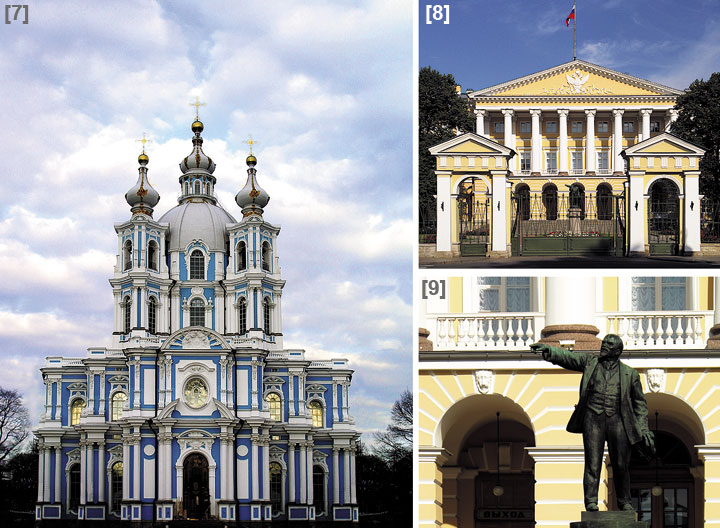ROUTE No. 6
SMOLNYY DISTRICT: SHPALERNAYA STREET – TAURIDE PALACE – TAURIDE GARDEN – MUSEUM OF ALEXANDER SUVOROV – STATUE OF FELIX DZERZHINSKY – KIKIN’S MANSION – SMOLNYY CONVENT – SMOLNYY INSTITUTE – STATUE OF VLADIMIR LENIN – LENINGRAD REGION GOVERNMENT BUILDING
Now we turn to Shpalernaya Street to go to Rastrelli and Proletariat Dictatorship Squares. Adjoining each other, these two squares are better known to visitors as the Smolnyy ensemble. The name “Smolnyy” derives from the “Smolyanoy Dvor” (pitch yard) which was established here in the times of Peter the Great to boil and store pitch for the Russian navy.
Shpalernaya Street was laid down in the early 18th century and was originally called Pervaya (First) or Kamennaya (Stone) Line. In the mid 18th century the street was renamed into Voskresenskaya (Resurrection) Street, because it was running towards the Smolnyy Resurrection Convent, which was then under construction. In 1859 Voskresenskaya Street was renamed into Shpalernaya (Tapestry) Street, to mark the fact that from 1730 till 1858 the famous tapestry manufactory was located here.
On the way to the right lies the Tauride Palace [1]. This area was presented by Catherine the Great to her favorite, Prince Grigoriy Potemkin, the brains behind the annexation of the Crimea (then known as Tauris). Completed by architect Vasiliy Stasov, the palace is one of the city’s earliest examples of an austere Neoclassicism. After Grigoriy Potemkin’s death the property passed to Catherine the Great, who lived there for some months each year during the latter years of her life. Her son Paul I had the splendid palace converted into barracks for the Horseguards’ Regiment, turning some of the colonnaded halls into stables, but after Paul’s death Emperor Alexander I restored it for use by members of the Imperial family. The interior was again completely altered when the State Duma moved into it in 1906. Today the exterior of the yellow and white palace still appears as it did shortly after it was completed.
Opposite the Tauride Palace is the tower of the main waterworks, built of dark brick in 1863. The Museum “Water World of St. Petersburg” [2] located there will tell you about water mysteries.

Behind the Tauride Palace lies the verdant Tauride Garden [3], stretching over an area of 30 hectares. It was landscaped in true Romantic style, designed to imitate nature, with ponds and canals and picturesque rolling landscape. Trees and shrubs were brought in especially from England. From the 19th century the Tauride Garden has been the favorite for afternoon strolls and children’s play. Artists held exhibitions here and free concerts were held, while in winter there was sledding and skating on frozen ponds. Later in the 20th century sports facilities and attractions were put in.
On the southern edge of the Tauride Garden, on Kirochnaya Street is the Museum of Alexander Suvorov [4]. It was solemnly consecrated and opened on November 13, 1904 to mark the 175th anniversary of Alexander Suvorov’s birthday. The central hall of the museum displays a stained glass gala portrait of Alexander Suvorov, his military awards and personal firearms, along with trophies of the Russian army and Russian and Turkish trophy banners.
On the opposite side of Shpalernaya Street, a few hundred meters east of the Tauride Palace, stands the Statue of Felix Dzerzhinsky [5] – founder of the Bolshevik secret police, the Cheka. Sculptors Vladimir Gorevoy and Sergey Kubasov have captured in bronze his decisiveness and iron will.
Just past the statue is the former Kikin’s Mansion [6] built in 1714 by the architect Andreas Schulter for Boyar Kikin who was beheaded for organizing a conspiracy against Peter the Great together with the Tsar’s son Alexey.

The bright blue painted Smolnyy Convent [7] is the main landmark of the area. In 1748 Empress Elizabeth commissioned Bartolomeo Rastrelli to construct a convent where she intended to spend her old age. Elizabeth died, however, before the convent was completed, and her successor Catherine the Great turned Smolnyy Convent into a boarding school for daughters of the nobility – the Smolnyy Institute for Young Noblewomen. After the revolution the cathedral was converted into an exhibition hall. Today it remains a venue for concerts where Russian spiritual music is performed. In the 19th century the Institute for Young Noblewomen moved into the neighboring yellow Smolnyy Institute [8] specially built by Giacomo Quarenghi. This building, well seen through the propylaea from the center of the Proletariat Dictatorship Square, later became the headquarters of the Bolsheviks during the October revolution of 1917. The leader of the world’s proletariat Vladimir Lenin [9] lived and worked in the Smolnyy for 124 days. Today the former Smolnyy Institute building houses the St. Petersburg Governor’s office.
Opposite the propylaea, on the corner of Suvorovskiy Prospect, stands the Leningrad Region Government Building [10]. Its facade is faced with light-coloured slabs of dolomite brought from the Estonian island of Saaremaa.
